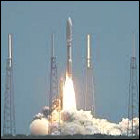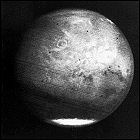 NASA launches the unmanned Juno space probe on its way to Jupiter, on a trajectory that will accelerate the vehicle through a series of maneuvers, including a gravity assist pass of Earth, en route to Jupiter. Once it arrives at the solar system’s largest planet, Juno will enter a polar orbit to monitor the planet’s clouds and magnetic field over a period of one year beginning in 2016. Juno is solar-powered, without the customary nuclear power source that has been a feature of all previous outer solar system missions. Since it will spend time within the heaviest area of Jupiter’s magnetosphere, Juno’s components are built into a hexagonal structure which acts as a heavy-duty Faraday cage to block out the radiation trapped within Jupiter’s magnetic field.
NASA launches the unmanned Juno space probe on its way to Jupiter, on a trajectory that will accelerate the vehicle through a series of maneuvers, including a gravity assist pass of Earth, en route to Jupiter. Once it arrives at the solar system’s largest planet, Juno will enter a polar orbit to monitor the planet’s clouds and magnetic field over a period of one year beginning in 2016. Juno is solar-powered, without the customary nuclear power source that has been a feature of all previous outer solar system missions. Since it will spend time within the heaviest area of Jupiter’s magnetosphere, Juno’s components are built into a hexagonal structure which acts as a heavy-duty Faraday cage to block out the radiation trapped within Jupiter’s magnetic field.
 The 20th episode of Sydney Newman’s spy series The Avengers, starring Ian Hendry and Patrick Macnee, airs on UK broadcaster ABC. This is one of only three first season episodes that still exists in its entirety.
The 20th episode of Sydney Newman’s spy series The Avengers, starring Ian Hendry and Patrick Macnee, airs on UK broadcaster ABC. This is one of only three first season episodes that still exists in its entirety.
 Radio and television stations across the United States begin mandatory participation in the national Emergency Broadcast System, a nationwide civil defense alert network replacing the CONELRAD system of the 1950s. Much like CONELRAD, EBS tests and activations initially require the rapid shutdown and reactivation of transmitters, at least until that practice is abolished in favor of a two-tone warning sound in the 1970s. Though the switch from CONELRAD to EBS is sparked by the
Radio and television stations across the United States begin mandatory participation in the national Emergency Broadcast System, a nationwide civil defense alert network replacing the CONELRAD system of the 1950s. Much like CONELRAD, EBS tests and activations initially require the rapid shutdown and reactivation of transmitters, at least until that practice is abolished in favor of a two-tone warning sound in the 1970s. Though the switch from CONELRAD to EBS is sparked by the 
 The unmanned NASA/JPL space probe Mariner 7 makes its closest flyby of planet Mars, coming as close as just over 2100 miles from the Martian surface. Having recently suffered an inexplicable but temporary loss of communications with Earth (later determined to be caused by a leaky on-board battery), Mariner 7’s flight plan is reprogrammed just days out from Mars based on some of the more interesting findings of its sister ship, Mariner 6. The success of the tandem flight to Mars convinces NASA to adopt a similar mission profile for the upcoming Mars ’71 missions, which will send two Mariner orbiters to take up permanent positions around Mars.
The unmanned NASA/JPL space probe Mariner 7 makes its closest flyby of planet Mars, coming as close as just over 2100 miles from the Martian surface. Having recently suffered an inexplicable but temporary loss of communications with Earth (later determined to be caused by a leaky on-board battery), Mariner 7’s flight plan is reprogrammed just days out from Mars based on some of the more interesting findings of its sister ship, Mariner 6. The success of the tandem flight to Mars convinces NASA to adopt a similar mission profile for the upcoming Mars ’71 missions, which will send two Mariner orbiters to take up permanent positions around Mars. ITV airs the second episode of Ace Of Wands, starring Michael McKenzie, Tony Selby and Judy Loe. David Prowse (Star Wars) guest stars. This episode, like the rest of the series’ first two seasons, is now missing from the archives.
ITV airs the second episode of Ace Of Wands, starring Michael McKenzie, Tony Selby and Judy Loe. David Prowse (Star Wars) guest stars. This episode, like the rest of the series’ first two seasons, is now missing from the archives. The
The  Russia launches Soyuz TM-26 on a mission to the Mir space station, which suffered numerous major malfunctions and damage during its previous crew’s stay. Aboard the Soyuz are specially selected cosmonauts Anatoly Solovyev and Pavel Vinogradov, who have trained on the ground to inspect and repair the damage to the station, though they are unable to find the hull damage to the now-abandoned Spektr module which threatened to cause total decompression of the station. They do manage to restore most of Mir’s solar power generating capability during their 197-day stay, returning to Earth in February 1998 with French spationaut Léopold Eyharts.
Russia launches Soyuz TM-26 on a mission to the Mir space station, which suffered numerous major malfunctions and damage during its previous crew’s stay. Aboard the Soyuz are specially selected cosmonauts Anatoly Solovyev and Pavel Vinogradov, who have trained on the ground to inspect and repair the damage to the station, though they are unable to find the hull damage to the now-abandoned Spektr module which threatened to cause total decompression of the station. They do manage to restore most of Mir’s solar power generating capability during their 197-day stay, returning to Earth in February 1998 with French spationaut Léopold Eyharts. The
The  Sci-Fi channel airs the
Sci-Fi channel airs the  Sci-Fi Channel airs the 27th episode of the science fiction series Eureka, starring Colin Ferguson, Salli Richardson, and Joe Morton. Niall Matter (Primeval: New World) guest stars.
Sci-Fi Channel airs the 27th episode of the science fiction series Eureka, starring Colin Ferguson, Salli Richardson, and Joe Morton. Niall Matter (Primeval: New World) guest stars. NASA launches the unmanned Juno space probe on its way to Jupiter, on a trajectory that will accelerate the vehicle through a series of maneuvers, including a gravity assist pass of Earth, en route to Jupiter. Once it arrives at the solar system’s largest planet, Juno will enter a polar orbit to monitor the planet’s clouds and magnetic field over a period of one year beginning in 2016. Juno is solar-powered, without the customary nuclear power source that has been a feature of all previous outer solar system missions. Since it will spend time within the heaviest area of Jupiter’s magnetosphere, Juno’s components are built into a hexagonal structure which acts as a heavy-duty Faraday cage to block out the radiation trapped within Jupiter’s magnetic field.
NASA launches the unmanned Juno space probe on its way to Jupiter, on a trajectory that will accelerate the vehicle through a series of maneuvers, including a gravity assist pass of Earth, en route to Jupiter. Once it arrives at the solar system’s largest planet, Juno will enter a polar orbit to monitor the planet’s clouds and magnetic field over a period of one year beginning in 2016. Juno is solar-powered, without the customary nuclear power source that has been a feature of all previous outer solar system missions. Since it will spend time within the heaviest area of Jupiter’s magnetosphere, Juno’s components are built into a hexagonal structure which acts as a heavy-duty Faraday cage to block out the radiation trapped within Jupiter’s magnetic field. American pay cable channel Starz premieres the
American pay cable channel Starz premieres the